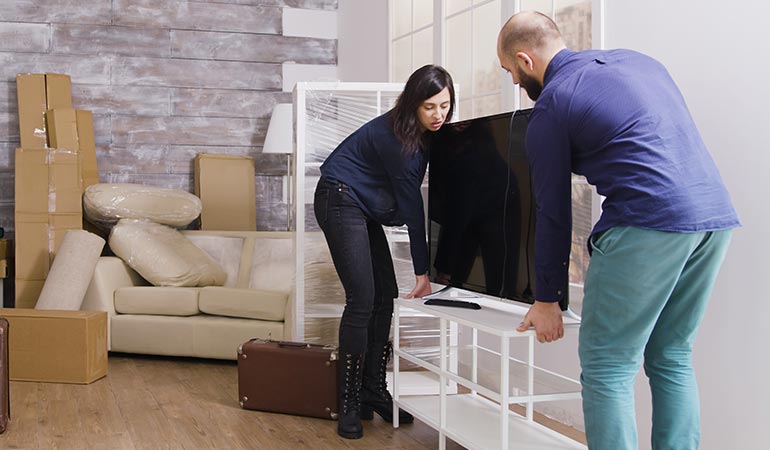
You’re sitting in your living room, packing your things in boxes, when you suddenly look up at the TV and immediately feel stressed. “How am I supposed to move that?” you ask yourself.
Don’t worry. It is not as hard as it seems. You just need to learn how to pack a TV for moving safely and without damage. This article will teach you just that.
Now you will learn the step-by-step method to guarantee your TV reaches your new place without a scratch.
Table of Contents
Get your packing supplies ready
First things first, get all your packing materials close by to make the process smoother and more efficient. You will need…
- Bubble wrap;
- Packing tape;
- Cardboard boxes (original box if available);
- Foam corner protectors;
- Blankets or towels.
That’s pretty much what you need to get started. If you still have the TV’s original box, you’re in luck. Since it’s designed for the appliance’s size, it is the safer option. These boxes also come with handles for a better grip when moving and foam cushioning that absorbs any shocks.
However, in case you can’t find it or you threw it away and are wondering if you can use a regular box to move a TV, the answer is yes. You can go with a double-walled moving box, opt for a proper flat-screen TV box, or get creative and join two large ones if needed. Just make sure it’s sturdy, fits your TV fairly well, and can handle a few bumps along the way.
If you wonder where to get boxes of this size, there are plenty of places where you can find free moving boxes, like online groups, discount stores, department stores and other of that sort.
Check also
The type of TV matters, so check your model
Before anything gets boxed up, it’s worth checking exactly what type of television you own. Each model has its own handling requirements.
LED and LCD units tend to be on the lighter side, but their screens are vulnerable and can crack easily without the right padding.
OLED varieties are even more fragile. They’re slimmer and more sensitive, particularly along the edges where damage is most likely to occur.
Plasma TVs are noticeably heavier. Their glass screens make them especially vulnerable to bumps. To move one safely, you’ll need sturdy packaging and plenty of cushioning. So, always get as much packing materials as you can. This is one of the must-follow rules when you pack fragile items for relocation.
The dimensions of your TV also come into play. A 55-inch model can usually be handled by one person, but anything larger, like a 65 or 75-inch screen, calls for a stronger box and a second set of hands.
You still pack large TV sets as you would smaller ones, however, bulkier TVs need more caution during the lift and the move.
Clean the TV
This might seem like overkill, but skipping this step could put your appliance at risk. Cleaning your television means that there are fewer chances of scratches from debris on the screen.
A quick tip: Do not use paper towels on a flat-screen TV. Their rough fibres can leave behind fine scratches and lint, especially on delicate surfaces like LED or OLED displays.
Instead, you can use a microfibre cloth. It’s more suitable for this task, leaving no traces behind. Spray it with a screen-safe solution and wipe the device clean. Never spray directly onto the device.
Disconnect any accessories and label them
Take a picture of your TV set up before you start unplugging any accessories from the device. The snapshot will help you later when you set up every cord, cable and speaker at your new place.
Then, pack these items into zip-lock bags, and using a roll of labels or masking tape, label each one with its contents. This will keep things organised when you unpack.
Check also
Remove the base or mount
If your TV sits on a stand or has a wall mount attached, you should remove it before packing. This is important for two reasons:
- They are bulky and will be inconvenient when packing.
- They can press against the device and cause damage during transportation.
Before you start unscrewing anything, take a good look first. Some models hide screws behind panels or use tricky locking mechanisms you might miss. If you’re not sure, check the manual. This is always better than forcing something and breaking it accidentally.
Once removed, wrap the base or bracket in bubble wrap or a thick cloth, and keep it separate from the screen.
Gently wrap the screen
Now, to wrap your TV for moving, begin by laying out a clean sheet of bubble wrap. Place the screen on it and fold the edges. Tape the edges and be careful not to press down too tightly.
Once that’s done, wrap the TV with a soft towel or a moving blanket to give it more padding. For added protection, you could slide in a foam sheet or even a screen protector before bundling it all up.
Secure the edges and corners
Edges and corners are usually the most susceptible to damage, so it’s important to protect them properly. Foam protectors are easy to use and widely available. However, if you’re being resourceful, sliced-up pool noodles or some well-folded cardboard will do just fine.
If you skip this step, you’re leaving your item vulnerable—one knock in transit is all it takes to cause a crack or chip.
We don’t just pack. We protect. Book now and let our team handle your fragile items.
Let's Get in TouchFor questions about the services we offer visit our main site or you can always call us at 020 3746 0584
Place into the original TV box or do a custom wrapping
If you’ve still got the original TV box, you’re already ahead. Carefully slide the TV into the foam inserts, making sure all sides and corners are well supported.
Once it’s in, close the box and seal every edge with strong packing tape, especially along the bottom and sides where damage is more likely.
And again, don’t worry if you don’t have the original box. What you can do now, after wrapping it up, is to place it into a double-walled moving box that matches the screen’s dimensions.
This type of box works especially well when the TV is heading overseas or travelling long distances. Anyway, whatever option you choose, make sure the fit is snug.
Which brings us to the last point—fill any remaining space with crumpled packing paper, soft clothing or cushions. This prevents the TV from shifting during the move till it reaches its drop-off point.
Check also
Label and do final checks
The final step in packing your flat screen TV is to label each box clearly. Use the colour for the room the TV will go in once at your new place. This is known as the room-by-room labelling method and you can learn more about it on our post on how to label your moving boxes.
Write “FRAGILE” and “THIS SIDE UP” in bold so there’s no confusion for whoever is moving them. That warning label might be the only thing standing between your valuables and avoidable damage.
Here’s a smart extra tip: If your TV is going into storage or will be travelling for a while, throw in a few silica gel packets into the box. They help prevent moisture build-up and keep your device safe.
How should a flat screen TV be stored?
If your flat screen is heading into storage for a while, a bit of prep work can make all the difference. Those screens are surprisingly easy to damage if not stored right.
So, always keep it upright. Laying it flat could seem harmless, but even light pressure can cause hidden cracks. It is also not safe to store a TV upside down, as the internal parts don’t cope well with that kind of pressure, especially in ultra-slim designs.
Store it somewhere dry and steady. Garages, lofts, or storage units are fine, as long as there’s no moisture around. But still, throw in a few silica gel packets just to be safe. Finally, make sure nothing ends up sitting on top of the appliance.
Why not just hire professional movers and ensure your TV’s safe transportation?
There’s nothing wrong with packing up your own television if it’s manageable and you’ve got the time. However, some situations are best left to people who do this kind of thing every day.
It’s not that simple to move TVs that are 65 inches or bigger. And things get even trickier if it’s mounted to a wall or custom-fitted.
Without the right tools or a clear idea of how it’s attached, you could quickly find yourself spending ages fiddling with screws that don’t even need removing.
Wondering how removalists move TVs without breaking a sweat? They know the right way to wrap and protect your screen, plus how to navigate those narrow stairwells without damage. You’ll save time, skip the headache, and keep that new display intact.
No cracks, no weird lines, no “why won’t it turn on?” moment while everyone stands around pretending not to panic.
Let Fantastic Removals pack your tv set!
Enter your postcode to view our rates and availability in your area.
For questions about the services we offer visit our main site or you can always call us at 020 3746 0584
Takeaways
- Gather all packing supplies in advance.
- Always clean the screen and disconnect accessories before wrapping anything.
- Use the original box if possible or a heavy-duty alternative with proper padding.
- Keep the TV upright, protect the corners, and fill any empty space to prevent movement.
- For oversized or wall-mounted units, consider hiring professional packers to avoid damage.








